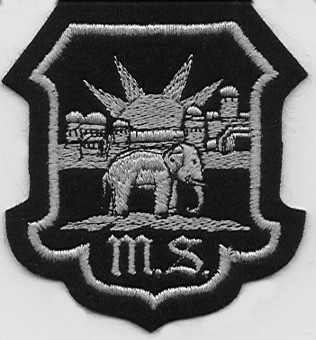History of School Cricket Milton 1910 - 1970 - Rhodesian players, Plumtree results
Full
pdf version (4 pages)
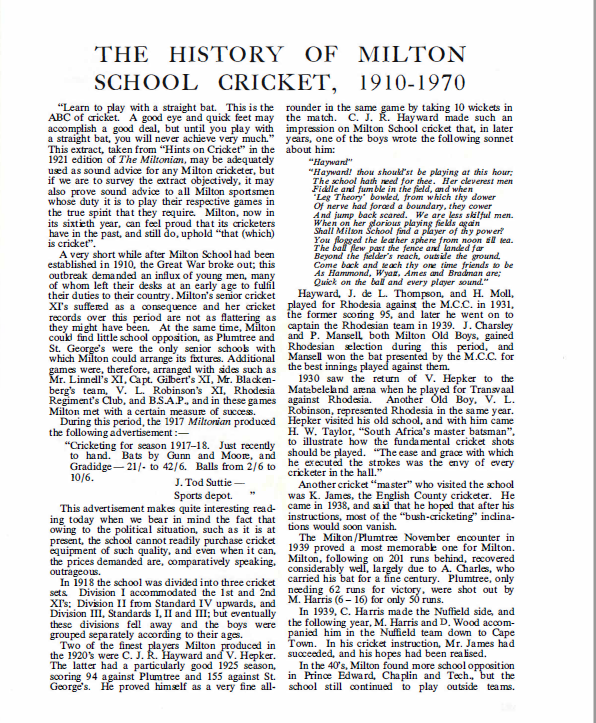
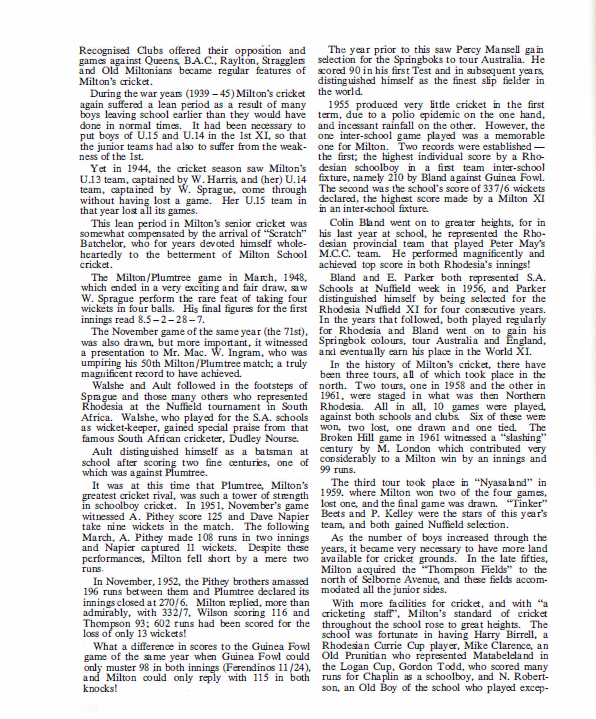
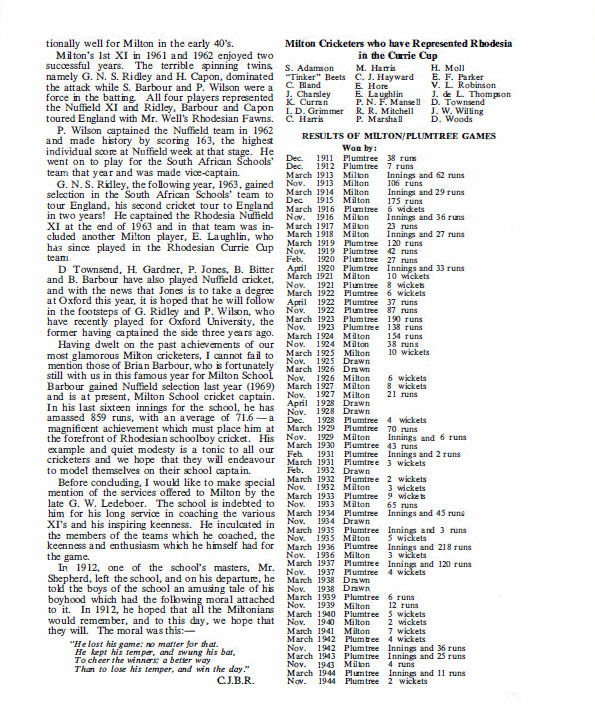
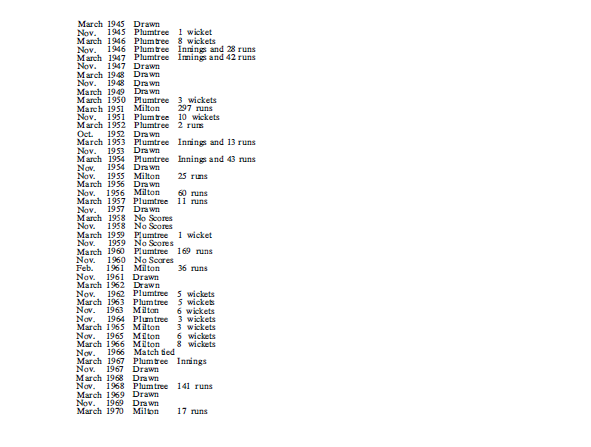
THE HISTORY OF SCHOOL CRICKET, MILTON 1910-1970
"Learn to play with a straight bat. This is the ABC of cricket. A good
eye and quick feet may
accomplish a good deal, but until you play with a straight bat, you will
never achieve very much."This extract, taken from "Hints on Cricket" in the 1921 edition of The
Miltonian, may be adequately used as sound advice for any Milton
cricketer, but if we are to survey the extract objectively, it may also
prove sound advice to all Milton sportsmen whose duty it is to play
their respective games in the true spirit that they require. Milton, now
in its sixtieth year, can feel proud that its cricketers have in the
past, and still do, uphold "that (which) is cricket".
A very short while after Milton School had been established in 1910, the
Great War broke out; this outbreak demanded an influx of young men, many
of whom left their desks at an early age to fulfill their duties to
their country. Milton's senior cricket Xi's suffered as a consequence
and her cricket records over this period are not as flattering as they
might have been. At the same time, Milton could find little school
opposition, as Plumtree and St. George's were the only senior schools
with which Milton could arrange its fixtures. Additional games were,
therefore, arranged with sides such as Mr. Linnell's XI, Capt. Gilbert's
XI, Mr. Blackenberg's team, V. L. Robinson's XI, Rhodesia Regiment's
Club, and B.S.A.P., and in these games Milton met with a certain measure
of success. During this period, the 1917 Miltonian produced the
following advertisement : -
"Cricketing for season 1917-18. Just recently to hand. Bats by Gunn and
Moore, and Gradidge - 21/· to 42/6. Balls from 2/6 to 10/6. J. Tod
Suttie - Sports depot. "
This advertisement makes quite interesting reading today when we bear in
mind the fact that
owing to the political situation, such as it is at present, the school
cannot readily purchase cricket equipment of such quality, and even when
it can, the prices demanded are, comparatively speaking, outrageous.
In 1918 the school was divided into three cricket sets. Division I
accommodated the 1st and 2nd XI's; Division II from Standard IV upwards,
and Division III, Standards I, II and III; but eventually these
divisions fell away and the boys were grouped separately according to
their ages. Two of the finest players Milton produced in the 1920's were
C. J. R. Hayward and V. Hepker.
The latter had a particularly good 1925 season, scoring 94 against
Plumtree and 155 against St. George's. He proved himself as a very fine
all-rounder in the same game by taking 10 wickets in the match. C. J. R.
Hayward made such an impression on Milton School cricket that, in later
years, one of the boys wrote the following sonnet about him:
"Hayward"
"Hayward! thou should'st be playing at this hour;
The school hath need for thee. Her cleverest men
Fiddle and fumble in the field, and when
'Leg 'Theory' bowled, from which thy dower
Of nerve had forced a boundary, they cower
And jump back scared. We are less skilful men.
When on her glorious playing fields again
Shall Milton School find a player of thy power?
You flogged the leather sphere from noon till tea.
The ball -flew past the fence and landed far
Beyond the fielder's reach, outside the ground.
Come back and teach .thy one time friends to be
As Hammond, Wyatt, Ames and Bradman are;
Quick on the ball and every player sound."
Hayward, J. de L. Thompson, and H. Moll played for Rhodesia against the
M.C.C. in 1931, the former scoring 95, and later he went on to captain
the Rhodesian team in 1939. J. Charsley and P. Mansell, both Milton Old
Boys, gained Rhodesian selection during this period, and Mansell won the
bat presented by the M.C.C. for the best innings played against them.
1930 saw the return of V. Hepker to the Matabeleland arena when he
played for Transvaal against Rhodesia. Another Old Boy, V. L. Robinson,
represented Rhodesia in the same year. Hepker visited his old school,
and with him came H. W. Taylor, "South Africa's master batsman", to
illustrate how the fundamental cricket shots should be played. "The ease
and grace with which he executed the strokes was the envy of every
cricketer in the hall."
Another cricket ''master" who visited the school was K. James, the
English County cricketer. He came in 1938, and said that he hoped that
after his instructions, most of the "bush-cricketing" inclinations would
soon vanish.
The Milton/Plumtree November encounter in 1939 proved a most memorable
one for Milton.
Milton, following on 201 runs behind, recovered considerably well,
largely due to A. Charles, who carried his bat for a fine century.
Plumtree, only needing 62 runs for victory, were shot out by M. Harris
(6 - 16) for only 50 runs. In 1939, C. Harris made the Nuffield side,
and the following year, M. Harris and D. Wood accompanied him in the
Nuffield team down to Cape Town. In his cricket instruction, Mr. James
had succeeded, and his hopes had been realised.
In the 40's, Milton found more school opposition in Prince Edward,
Chaplin and Tech., but the school still continued to play outside teams.
Recognised Clubs offered their oppos1t1on and games against Queens,
B.A.C., Raylton, Stragglers and Old Miltonians became regular features
of Milton's cricket.
During the war years (1939 - 45) Milton's cricket again suffered a lean
period as a result of many boys leaving school earlier than they would
have done in normal times. It had been necessary to put boys of U.15 and
U.14 in the 1st XI, so that the junior teams had also to suffer from the
weakness of the 1st.
Yet in 1944, the cricket season saw Milton's U.13 team, captained by W.
Harris, and (her) U.14 team, captained by W. Sprague, come through
without having lost a game. Her U.15 team in that year lost all its
games. This lean period in Milton's senior cricket was somewhat
compensated by the arrival of "Scratch" Batchelor, who for years devoted
himself wholeheartedly to the betterment of Milton School cricket.
The Milton/Plumtree game in March, 1948, which ended in a very exciting
and fair draw, saw
W. Sprague perform the rare feat of taking four wickets in four balls,
His final figures for the first innings read 8.5 - 2- 28 - 7. The
November game of the same year (the 71st), was also drawn, but more
important it witnessed a presentation to Mr. Mac. W. Ingram, who was
umpiring his 50th Milton/Plumtree match; a truly magnificent record to
have achieved. Walshe and Ault followed in the footsteps of Sprague and
those many others who represented Rhodesia at the Nuffield tournament in
South Africa. Walshe, who played for the S.A. schools as wicket-keeper,
gained special praise from that famous South African cricketer. Dudley
Nourse. Ault distinguished himself as a batsman at school after scoring
two fine centuries, one of which was against Plumtree. It was at this
time that Plumtree, Milton's greatest cricket rival, was such a tower of
strength in schoolboy cricket. In 1951, November's game witnessed A.
Pithey score 125 and Dave Napier take nine wickets in the match. The
following March, A. Pithey made 108 runs in two innings and Napier
captured 11 wickets. Despite these performances, Milton fell short by a
mere two runs.
In November, 1952, the Pithey brothers amassed 196 runs between them and
Plumtree declared its innings closed at 270/ 6. Milton replied, more
than admirably, with 332/7, Wilson scoring 116 and Thompson 93; 602 runs
had been scored for the loss of only 13 wickets!
What a difference in scores to the Guinea Fowl game of the same year
when Guinea Fowl could only muster 98 in both innings (Ferendinos 11
/24), and Milton could only reply with 115 in both knocks!
The year prior to this saw Percy Mansell gain selection for the
Springboks to tour Australia. He scored 90 in his first Test and in
subsequent years, distinguished himself as the finest slip fielder in
the world. 1955 produced very little cricket in the first term, due to a
polio epidemic on the one hand, and incessant rainfall on the other.
However, the one inter-school game played was a memorable one for
Milton. Two records were established - the first; the highest individual
score by a Rhodesian schoolboy in a first team inter-school fixture,
namely 210 by Bland against Guinea Fowl. The second was the school's
score of 337 /6 wickets declared, the highest score made by a Milton XI
in an inter-school fixture. Colin Bland went on to greater heights, for
in his last year at school, he represented the Rhodesian provincial team
that played Peter May's M.C.C. team. He performed magnificently and
achieved top score in both Rhodesia's innings!
Bland and E. Parker both represented S.A. Schools at Nuffield week in
1956, and Parker distinguished himself by being selected for the
Rhodesia Nuffield XI for four consecutive years.
In the years that followed, both played regularly for Rhodesia and Bland
went on to gain his
Springbok colours, tour Australia and England, and eventually earn his
place in the World XI.
In the history of Milton's cricket, there have been three tours, all of
which took place in the north. Two tours, one in 1958 and the other in
1961, were staged in what was then Northern Rhodesia. All in all, 10
games were played, against both schools and clubs. Six of these were
won, two lost, one drawn and one tied. The Broken Hill game in 1961
witnessed a "slashing" century by M. London which contributed very
considerably to a Milton win by an innings and 99 runs.
The third tour took place in "Nyasaland" in 1959 where Milton won two of
the four games, lost one, and the final game was drawn. "Tinker" Beets
and P. Kelley were the stars of this year's team, and both gained
Nuffield selection. As the number of boys increased through the years,
it became very necessary to have more land available for cricket
grounds. In the late fifties, Milton acquired the "Thompson Fields" to
the north of Selborne Avenue, and these fields accommodated all the
junior sides. With more facilities for cricket, and with "a cricketing
staff", Milton's standard of cricket throughout the school rose to great
heights. The school was fortunate in having Harry Birrell, a Rhodesian
Currie Cup player, Mike Clarence, an Old Prunitian who represented
Matabeleland in the Logan Cup, Gordon Todd, who scored many runs for
Chaplin as a schoolboy, and N. Robertson, an Old Boy of the school who
played exceptionally well for Milton in the early 40's. Milton's 1st XI
in 1961 and 1962 enjoyed two successful years. The terrible spinning
twins, namely G. N. S. Ridley and H. Capon, dominated the attack while
S. Barbour and P. Wilson were a force in the batting, All four players
represented the Nuffield XI and Ridley, Barbour and Capon toured England
with Mr. Well's Rhodesian Fawns. P. Wilson captained the Nuffield team
in 1962 and made history by scoring 163, the highest individual score at
Nuffield week at that stage. He went on to play for the South African
Schools' team that year and was made vice-captain. G. N. S. Ridley, the
following year, 1963, gained selection in the South African Schools'
team to tour England, his second cricket tour to England in two years!
He captained the Rhodesia Nuffield XI at the end of 1963 and in that
team was included another Milton player, E. Laughlin, who has since
played in the Rhodesian Currie Cup team. D Townsend, H. Gardner, P.
Jones, B. Bitter and B. Barbour have also played Nuffield cricket, and
with the news that Jones is to take a degree at Oxford this year, it is
hoped that he will follow in the footsteps of G. Ridley and P. Wilson,
who have recently played for Oxford University, the former having
captained the side three years ago.
Having dwelt on the past achievements of our most glamorous Milton
cricketers, I cannot fail to mention those of Brian Barbour, who is
fortunately still with us in this famous year for Milton School. Barbour
gained Nuffield selection last year (1969) and is at present, Milton
School cricket captain.
In his last sixteen innings for the school, he has amassed 859 runs,
with an average of 71.6 - a magnificent achievement which must place him
at the forefront of Rhodesian schoolboy cricket. His example and quiet
modesty is a tonic to all our cricketers and we hope that they will
endeavour to model themselves on their school captain.
Before concluding, I would like to make special mention of the services
offered to Milton by the late G. W. Ledeboer. The school is indebted to
him for his long service in coaching the various XI's and his inspiring
keenness. He inculcated in the members of the teams which he coached,
the keenness and enthusiasm which he himself had for the game.
In 1912, one of the school's masters, Mr. Shepherd, left the school, and
on his departure, he told the boys of the school an amusing tale of his
boyhood which had the following moral attached to it. In 1912, he hoped
that all the Miltonians would remember, and to this day, we hope that
they will. The moral was this:-
"He lost his game: no matter for that.
He kept his temper, and swung his bat,
To cheer the winners; a better way
Than to lose his temper, and win the day."
C.J.B.R.
Milton Cricketers who have Represented Rhodesia in the Currie
Cup
S. Adamson
"Tinker" Beets
C. Bland
M. Harris
H. Moll
C. J. Hayward
E. F. Parker
J. Charsley
K. Curran
E. Hore
V. L. Robinson
E. Laughlin
J. de L. Thompson
P. N. F. Mansell
D. Townsend
I. D. Grimmer
C. Harris
R. R. Mitchell
J. W. Willing
P. Marshall
D. Woods
RESULTS OF MILTON/PLUMTREE GAMES - Plumtree 49, Milton
31, Draw 25, No result 4
YEAR
WINNER
SCORE
YEAR
WINNER
SCORE
1911
Dec
Plumtree
38 runs
1941
March
Milton
7 wickets
1912
Dec
Plumtree
7 runs
1942
March
Plumtree
4 wickets
1913
March
Milton
Innings and 62 runs
1942
Nov
Plumtree
Innings and 36 runs
1913
Nov
Milton
106 runs
1943
March
Plumtree
Innings and 25 runs
1914
March
Milton
Innings and 29 runs
1943
Nov
Milton
4 runs
1915
Dec
Milton
175 runs
1944
March
Plumtree
Innings and 11 runs
1916
March
Plumtree
6 wickets
1944
Nov
Plumtree
2 wickets
1916
Nov
Milton
Innings and 36 runs
1945
March
Drawn
1917
March
Milton
23 runs
1945
Nov
Plumtree
1 wicket
1918
March
Milton
Innings and 27 runs
1946
March
Plumtree
8 wickets
1919
March
Plumtree
120 runs
1946
Nov
Plumtree
Innings and 28 runs
1919
Nov
Plumtree
42 runs
1947
March
Plumtree
Innings and 42 runs
1920
Feb
Plumtree
27 runs
1947
Nov
Drawn
1920
April
Plumtree
Innings and 33 runs
1948
March
Drawn
1921
March
Milton
10 wickets
1948
Nov
Drawn
1921
Nov
Plumtree
8 wickets
1949
March
Drawn
1922
March
Plumtree
6 wickets
1950
March
Plumtree
3 wickets
1922
April
Plumtree
37 runs
1951
March
Milton
297 runs
1922
Nov
Plumtree
87 runs
1951
Nov
Plumtree
10 wickets
1923
March
Plumtree
190 runs
1952
March
Plumtree
2 runs
1923
Nov
Plumtree
138 runs
1952
Oct
Drawn
1924
March
Milton
154 runs
1953
March
Plumtree
Innings and 13 runs
1924
Nov
Milton
38 runs
1953
Nov
Drawn
1925
March
Milton
10 wickets
1954
March
Plumtree
Innings and 43 runs
1925
Nov
Drawn
1954
Nov
Drawn
1926
March
Drawn
1955
Nov
Milton
25 runs
1926
Nov
Milton
6 wickets
1956
March
Drawn
1927
March
Milton
8 wickets
1956
Nov
Milton
60 runs
1927
Nov
Milton
21 runs
1957
March
Plumtree
11 runs
1928
April
Drawn
1957
Nov
Drawn
1928
Nov
Drawn
1958
March
No Scores
1928
Dec
Plumtree
4 wickets
1958
Nov
No Scores
1929
March
Plumtree
70 runs
1959
March
Plumtree
1 wicket
1929
Nov
Milton
Innings and 6 runs
1959
Nov
No Scores
1930
March
Plumtree
43 runs
1960
March
Plumtree
169 runs
1931
Feb
Plumtree
Innings and 2 runs
1960
Nov
No Scores
1931
March
Plumtree
3 wickets
1961
Feb
Milton
36 runs
1932
Feb
Drawn
1961
Nov
Drawn
1932
March
Plumtree
2 wickets
1962
March
Drawn
1932
Nov
Milton
3 wickets
1962
Nov
Plumtree
5 wickets
1933
March
Plumtree
9 wickets
1963
March
Plumtree
5 wickets
1933
Nov
Milton
65 runs
1963
Nov
Milton
6 wickets
1934
March
Plumtree
Innings and 45 run
1964
Nov
Plumtree
3 wickets
1934
Nov
Drawn
1965
March
Milton
3 wickets
1935
March
Plumtree
Innings and 3 runs
1965
Nov
Milton
6 wickets
1935
Nov
Milton
5 wickets
1966
March
Milton
8 wickets
1936
March
Plumtree
Innings and 218 runs
1966
Nov
Match tied
1936
Nov
Milton
3 wickets
1967
March
Plumtree
Innings
1937
March
Plumtree
Innings and 120 runs
1967
Nov
Drawn
1937
Nov
Plumtree
4 wickets
1968
March
Drawn
1938
March
Drawn
1968
Nov
Plumtree
141 runs
1938
Nov
Drawn
1969
March
Drawn
1939
March
Plumtree
6 runs
1969
Nov
Drawn
1939
Nov
Milton
12 runs
1970
March
Milton
17 runs
1940
March
Plumtree
5 wickets
1940
Nov
Milton
2 wickets
